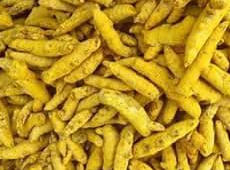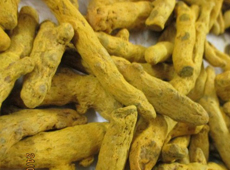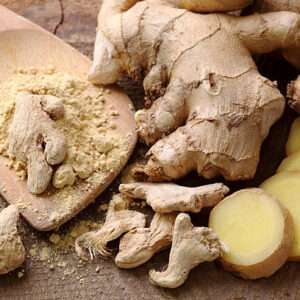In India, turmeric is known for its antiseptic and healing properties. Turmeric is used to add fragrance, colour and aroma to the dishes. The turmeric finger is the purest form of turmeric and is used in medicines, food and dyeing processes. The product is sourced from the farmers who grow the crop in natural and organic manner. Turmeric is widely grown in Erode. Turmeric powder is made from turmeric fingers. We offer optimum quality turmeric fingers at competitive prices.
Our Company is regarded as the most sought after exporter of wide range of Turmeric finger. These are renowned for their antiseptic attributes and are thus widely used for quick healing of wounds. Further, turmeric is mainly used to add color, fragrance and taste to dishes and gives an attractive appeal to the food preparation. Therefore, these are very popular among our international client base. The Color curcumin extracted from turmeric is used as a colourant. Turmeric is also used as a dye in textile industry.
Few popular grades of Indian Turmeric Finger are
- Aleppo Finger (Kerala)
- Erode Finger from Tamil Nadu
- Rajapuri Turmeric from Sangli (Maharashtra)
- Nizamabad Turmeric from Andhra Pradesh
- Cuddapah Turmeric from Andhra Pradesh
Types of Indian Turmeric Finger
- Turmeric Finger Bold
- Turmeric Finger Curcuma
- Turmeric Finger Sannam
- Turmeric Finger Bulp
| Curcuma | Bold | Sannam | Bulp | |
|---|---|---|---|---|
| Curcumin | 5.0% | 3.6%-4.0% | 3.2%-3.6% | 4.0% |
| Moisture | 10% | 10%-12% | 12% | 10%-12% |

Turmeric Sannam

Turmeric Bold

Turmeric Bulp

Turmeric Curcuma
Common Packing For Container Shipment
| Products | Packing | Container |
|---|---|---|
| Turmeric Fingers | 25kg PP/Jute Bags | 640 Bags in 20’FCL |
| 50kg PP/Jute Bags | 320 Bags in 20’FCL |
Origin of Turmeric Finger with production

Nutrition Facts
- Serving Size: 100gm
- Amounts per servings
- % Daily Values*
-
Naicin32%folates10%
-
Pyridoxine138%Riboflavin18%
-
Vitamin A0%Vitamin C43%
-
Vitamin D0%Vitamin E21%
-
Vitamin K11%Magnesium48%
-
Sodium2.5%Potassium54%
-
Calcium18%Iron517%
-
Copper67%%Manganese340%
-
Phosphorus38%Magnesium48%
- *Percent Daily Values are based on a 2,000 Calorie diet.
Facts on Turmeric Fingers
The Turmeric Finger when grounded in to fine powder serves as key ingredients in most of the foods and provide it with flavor and color. The turmeric finger is the purest form of turmeric and is used in medicines, food and dyeing processes. The product is sourced from the farmers who grow the crop in natural and organic manner.
Turmeric or Curcuma Longa is a member of the ginger family and is a handsome perennial with large lily-like leaves and clusters of flowers in spikes. A robust perennial grows to a height of 1 m ( 3 ft), and turmeric is usually propagated from ‘figures’ or small sections of rhizomes from the previous year’s growth , Turmeric is most often sole dried and ground.
Health benfits
- Turmeric has been in use since antiquity for its anti-inflammatory (painkiller), carminative, anti-flatulent and anti-microbial properties.
- The herb contains health benefiting essential oils such as turmerone, zingiberene, cineole, and p-cymene.
- Curcumin, a polyphenolic compound in the root, is the primary pigment that imparts deep orange color to the turmeric. Many laboratory animal studies have suggested that the curcumin may have anti-tumor, antioxidant, anti-arthritic, anti-amyloid, anti-ischemic, and anti-inflammatory properties.
- This traditional herb does not contain any cholesterol; however, it is rich in antioxidants and dietary fiber, which helps to control blood LDL or “bad cholesterol” levels.
- It is very rich source of many essential vitamins such as pyridoxine (vitamin B6), choline, niacin, and riboflavin, etc. 100 g herb provides 1.80 mg or 138% of daily recommended levels of pyridoxine. Pyridoxine is employed in the treatment of homocystinuria, sideroblastic anemia, and radiation sickness. Niacin helps prevent “pellagra” or dermatitis.
- The fresh root contains good levels of vitamin-C. 100 g compose of 23.9 mg of this vitamin. Vitamin-C is a water-soluble vitamin and a powerful natural antioxidant, which helps the body develop immunity against infectious agents, and remove harmful free oxygen radicals.
- Turmeric contains good amounts of minerals like calcium, iron, potassium, manganese, copper, zinc, and magnesium. Potassium is an important component of cell and body fluids that helps in controlling heart rate and blood pressure. The human body utilizes manganese as a co-factor for the antioxidant enzyme, superoxide dismutase. Iron is an essential co-factor for cytochrome oxidase enzymes at cellular level metabolisms and required for red blood cell (RBC’s) productions.



